Successful mixed reality projects in user engagement effectively combine digital content with the real world, creating immersive experiences that captivate users. By utilizing technologies such as augmented reality (AR) and virtual reality (VR), these projects foster deeper interaction and participation, ultimately enhancing user satisfaction and retention.
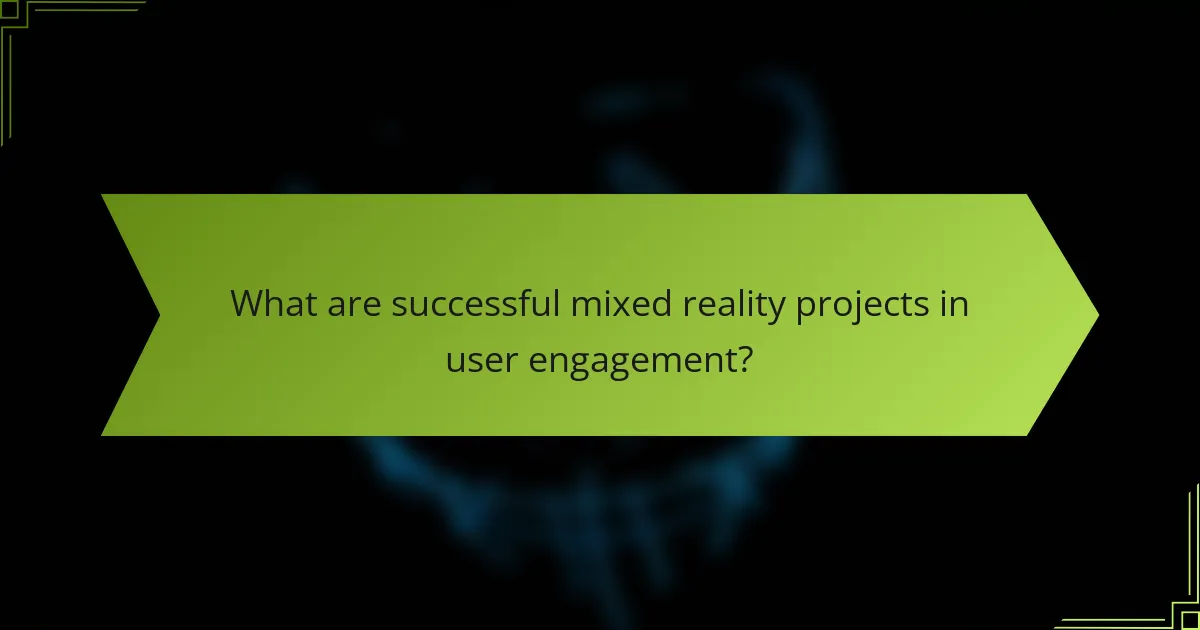
What are successful mixed reality projects in user engagement?
Successful mixed reality projects in user engagement blend digital content with the real world to enhance user experiences. These projects leverage technologies like augmented reality (AR) and virtual reality (VR) to create interactive environments that captivate users and encourage participation.
Microsoft HoloLens in retail
Microsoft HoloLens has transformed retail by allowing customers to visualize products in their own space before making a purchase. Retailers can use this mixed reality technology to create immersive experiences, such as virtual showrooms where users can interact with 3D models of products.
For example, furniture retailers can enable customers to see how a sofa fits in their living room through AR. This not only enhances user engagement but also reduces return rates, as customers make more informed decisions. Retailers should consider integrating HoloLens into their sales strategy to improve customer satisfaction and drive sales.
Magic Leap in education
Magic Leap has made significant strides in education by providing immersive learning experiences that engage students in new ways. Through mixed reality, educators can create interactive lessons that allow students to explore complex subjects, such as anatomy or astronomy, in a hands-on manner.
For instance, students can visualize and manipulate 3D models of the human body, enhancing their understanding of biology. Schools looking to adopt this technology should focus on curriculum integration and teacher training to maximize the benefits of Magic Leap’s capabilities.
Niantic’s Pokémon GO for community engagement
Niantic’s Pokémon GO exemplifies successful mixed reality in community engagement by encouraging players to explore their surroundings while capturing virtual creatures. This game uses location-based technology to create a shared experience that fosters social interaction and community involvement.
Players often gather at local landmarks and parks, participating in events that promote physical activity and community bonding. Organizations can learn from Pokémon GO’s model by creating similar experiences that encourage users to engage with their environment and each other, enhancing community ties and user loyalty.
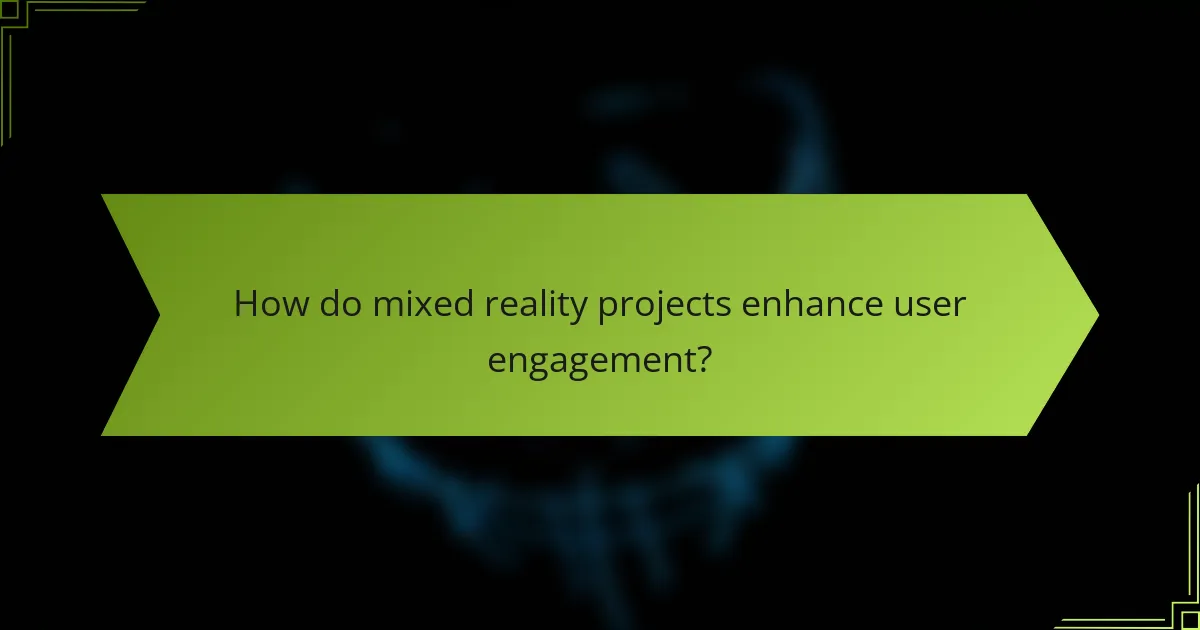
How do mixed reality projects enhance user engagement?
Mixed reality projects enhance user engagement by creating immersive environments that blend the physical and digital worlds. These experiences captivate users, encouraging deeper interaction and participation.
Immersive experiences
Immersive experiences in mixed reality transport users into virtual environments that feel real. This can involve everything from augmented reality applications that overlay digital information onto the physical world to fully immersive virtual reality simulations.
For example, a museum might use mixed reality to allow visitors to interact with historical artifacts in a lifelike manner. Users can explore 3D models, view animations, and even participate in guided tours that enhance their understanding and enjoyment.
Interactive storytelling
Interactive storytelling in mixed reality allows users to become part of the narrative, making choices that affect the outcome. This approach creates a personalized experience, fostering a stronger emotional connection to the content.
Consider a mixed reality game where players navigate a story by solving puzzles and interacting with characters. Each decision can lead to different scenarios, keeping users engaged and encouraging repeated play to explore all possible outcomes.
Real-time feedback
Real-time feedback in mixed reality projects enhances user engagement by providing immediate responses to actions. This can include visual cues, sound effects, or haptic feedback that reinforces the user’s interactions.
For instance, in a training simulation, users might receive instant feedback on their performance, allowing them to adjust their actions accordingly. This immediate reinforcement helps users learn more effectively and stay engaged throughout the experience.

What are the key metrics for measuring success?
Key metrics for measuring success in mixed reality projects include user retention rates, engagement time, and customer satisfaction scores. These metrics provide insights into how effectively the project captivates and retains users, ultimately influencing its overall success.
User retention rates
User retention rates indicate the percentage of users who continue to engage with a mixed reality application over a specific period. High retention rates suggest that users find value in the experience, while low rates may signal issues with content or usability.
To improve retention, focus on delivering regular updates and new features that keep the experience fresh. Aim for retention rates above 40% within the first month, as this is often considered a benchmark for successful applications.
Engagement time
Engagement time measures how long users spend interacting with a mixed reality project. Longer engagement times typically reflect a more immersive and compelling experience, which can lead to higher retention and satisfaction.
To boost engagement time, consider incorporating interactive elements and gamification. Aim for users to spend at least 15-30 minutes per session, as this range often correlates with meaningful engagement.
Customer satisfaction scores
Customer satisfaction scores gauge users’ overall happiness with a mixed reality experience. These scores can be collected through surveys or feedback forms, providing valuable insights into user perceptions and areas for improvement.
To enhance satisfaction, regularly solicit feedback and act on it. Target a satisfaction score of 80% or higher, as this level indicates a strong positive reception among users.
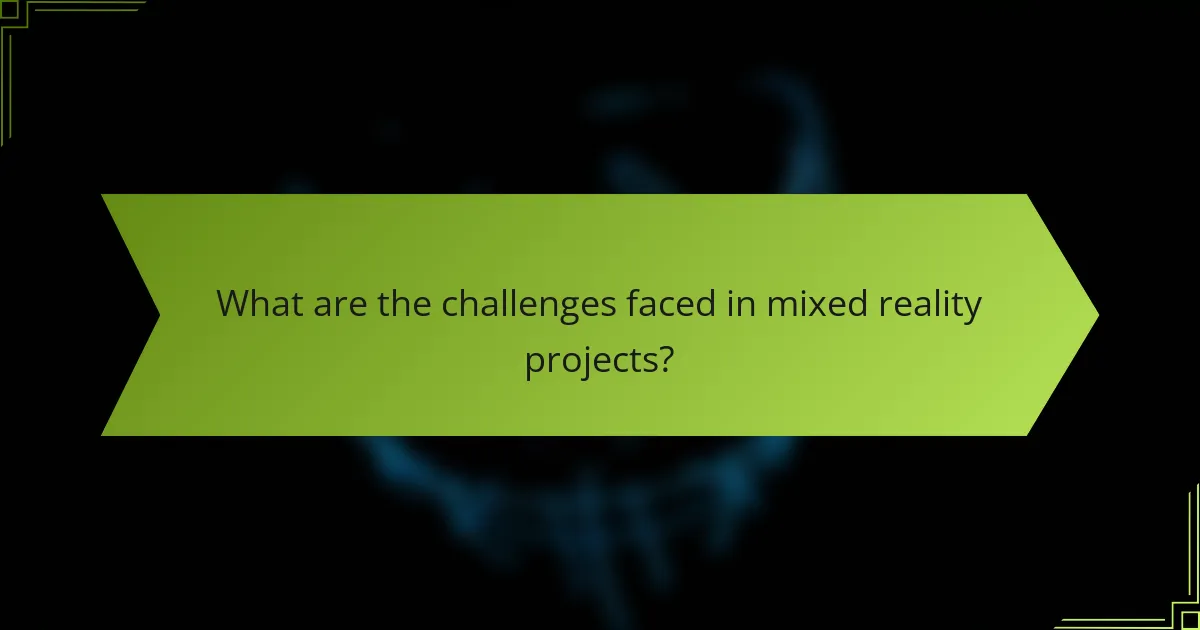
What are the challenges faced in mixed reality projects?
Mixed reality projects encounter several challenges that can hinder their success, including technical limitations, high development costs, and user adoption barriers. Addressing these issues is crucial for effective implementation and user engagement.
Technical limitations
Technical limitations in mixed reality often stem from hardware constraints and software compatibility issues. Devices may struggle with processing power, leading to latency or reduced visual fidelity, which can detract from the user experience.
Additionally, the integration of mixed reality with existing systems can be complex, requiring specialized knowledge and tools. Developers must ensure that the software runs smoothly across various devices, which can be a significant hurdle.
High development costs
The costs associated with developing mixed reality applications can be substantial, often ranging from tens of thousands to several million dollars, depending on the project’s scope. This includes expenses for hardware, software licenses, and skilled personnel.
Organizations must weigh the potential return on investment against these costs. Investing in prototyping and iterative development can help manage expenses and refine the product before full-scale deployment.
User adoption barriers
User adoption of mixed reality technologies can be slow due to unfamiliarity and perceived complexity. Many users may be hesitant to engage with new technology that requires learning new skills or adapting existing workflows.
To encourage adoption, developers should focus on creating intuitive interfaces and providing adequate training resources. Demonstrating clear benefits and ease of use can significantly enhance user willingness to embrace mixed reality solutions.
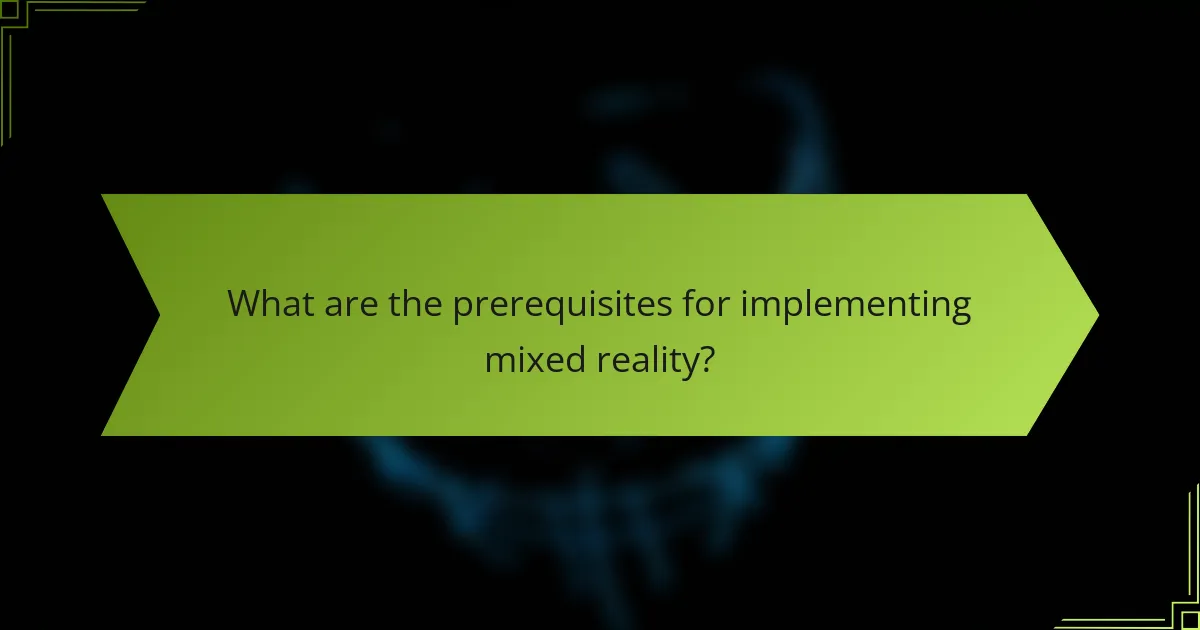
What are the prerequisites for implementing mixed reality?
Implementing mixed reality requires a solid foundation in technology, a skilled workforce, and a well-defined content strategy. These elements ensure that organizations can effectively create and maintain engaging mixed reality experiences.
Technology infrastructure
A robust technology infrastructure is essential for mixed reality projects. This includes high-performance hardware, such as powerful computers and headsets, as well as reliable software platforms that support mixed reality applications.
Organizations should consider investing in cloud services for data storage and processing, as well as ensuring strong network connectivity to handle real-time data exchange. Compatibility with existing systems and devices is also crucial to streamline the integration process.
Skilled workforce
A skilled workforce is vital for the successful implementation of mixed reality. This includes professionals with expertise in software development, 3D modeling, and user experience design. Training existing staff or hiring new talent can help bridge any skill gaps.
Collaboration between team members with different backgrounds, such as programmers and artists, can foster innovation and improve project outcomes. Organizations should prioritize ongoing education and professional development to keep skills current in this rapidly evolving field.
Content strategy
A clear content strategy is necessary to guide the creation of mixed reality experiences. This involves defining target audiences, understanding their needs, and determining the types of content that will engage them effectively.
Organizations should focus on creating interactive and immersive content that leverages the unique capabilities of mixed reality. Regularly reviewing and updating content based on user feedback can enhance engagement and ensure relevance over time.
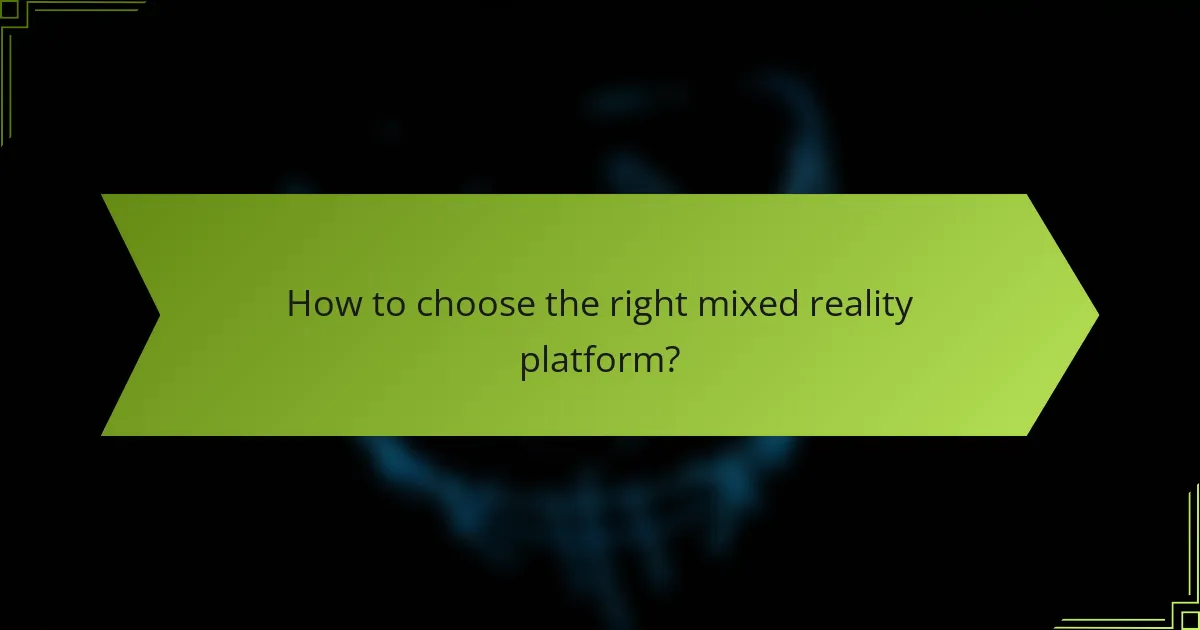
How to choose the right mixed reality platform?
Choosing the right mixed reality platform involves assessing compatibility with existing systems, user experience, and specific project needs. Consider factors like hardware requirements, software capabilities, and the target audience to ensure optimal engagement and functionality.
Platform compatibility
Platform compatibility refers to how well a mixed reality solution integrates with various devices and operating systems. It’s crucial to evaluate whether the platform supports the hardware your team will use, such as headsets or mobile devices, and whether it can operate across different operating systems like Windows, iOS, or Android.
When selecting a platform, check for compatibility with popular mixed reality devices such as Microsoft HoloLens, Oculus Quest, or Magic Leap. A platform that supports multiple devices can enhance accessibility and user engagement, allowing a broader audience to participate.
Additionally, consider the software ecosystem surrounding the platform. Look for platforms that offer robust development tools, community support, and integration with existing applications. This can streamline development and reduce time to market, ultimately leading to a more successful mixed reality project.
